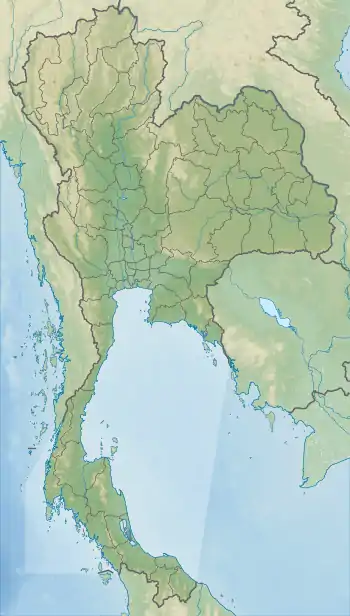Phu Kradung Formation
The Early Cretaceous Phu Kradung Formation is the lowest member of the Mesozoic Khorat Group which outcrops on the Khorat Plateau in Isan, Thailand. This geological formation consists of micaceous, brown to reddish-brown siltstone beds with minor brown and grey shale and sandstone beds. Occasional lime-noduled conglomerate occurs.[1]
| Phu Kradung Formation Stratigraphic range: Late Jurassic-Early Cretaceous ~?Tithonian–Berriasian | |
|---|---|
| Type | Geological formation |
| Unit of | Khorat Group |
| Underlies | Phra Wihan Formation |
| Overlies | Nam Phong Formation |
| Lithology | |
| Primary | Siltstone, mudstone |
| Other | Sandstone |
| Location | |
| Coordinates | 17.2°N 102.4°E |
| Approximate paleocoordinates | 14.7°N 108.5°E |
| Region | Isan |
| Country | |
| Extent | Khorat Plateau |
| Type section | |
| Named by | Ward & Bunnag |
| Year defined | 1964 |
 Phu Kradung Formation (Thailand) | |
The Phu Kradung Formation sediments were deposited in a lake-dominated floodplain cut by meandering and occasionally braided river channels.[2]
The Phu Kradung Formation is considered, on the basis of recent vertebrae fossil discoveries, to be Late Jurassic in age. However, new palynology data suggests an age of Early Cretaceous.[2]
Dinosaur remains have been recovered from this formation, although none have yet been referred to a specific genus.[3][4]
Chalawan, an extinct genus of pholidosaurid mesoeucrocodylian, is currently known solely from its holotype, a nearly complete mandible collected in the early 1980s from a road-cut near the town of Nong Bua Lamphu in the upper part of the Phu Kradung Formation. This single specimen is the most well preserved vertebrate fossil that has been found from the formation. It contains a single species, Chalawan thailandicus.[5]
Vertebrate paleofauna
- Basilochelys macrobios[6]
- Chalawan thailandicus - "mandible"[3][5]
- Eucryptodira indet.[3]
- Indosinosuchus potamosiamensis and I. kalasinensis - "disarticulated postcranial elements"[3][7][8]
- Mamenchisauridae indet. - "isolated posterior cervical vertebra"[3][4][9]
- Metriacanthosaurinae indet. - "a nearly complete left tibia"[10][11]
- Metriacanthosaurinae indet. - "Skull elements such as teeth, premaxillae, and maxillae as well as appendicular materials of more than one individual."[12]
- Stegosauridae indet. (informally known as Siamodracon altispinus) - "single dorsal vertebra"[3][13][14]
- Sunosuchus indet. - "isolated remains"[3]
- Rhamphorhynchidae indet "humerus"[15]
See also
References
- Suteetorn and Jarnyahran (1986). "Geological Map of Thailand 1:250,000, Sheet NE 48-14 (Roi Et).
- Racey and Goodall (2009). "Late Palaeozoic and Mesozoic Ecosystems in SE Asia". Geological Society. London. Special Publication 315 Pp 69-84.
- Weishampel, et al. (2004). "Dinosaur distribution." Pp. 517-607.
- Weishampel, David B.; Dodson, Peter; and Osmólska, Halszka (eds.): The Dinosauria, 2nd, Berkeley: University of California Press. 861 pp. ISBN 0-520-24209-2.
- Martin, J. E.; Lauprasert, K.; Buffetaut, E.; Liard, R.; Suteethorn, V. (2013). Angielczyk, Kenneth (ed.). "A large pholidosaurid in the Phu Kradung Formation of north-eastern Thailand". Palaeontology. 57 (4): 757–769. doi:10.1111/pala.12086.
- Tong, H.; Claude, J.; Naksri, W.; Suteethorn, V.; Buffetaut, E.; Khansubha, S.; Wongko, K. & Yuangdetkla, P. 2009. Basilochelys macrobios n. gen. and n. sp., a large cryptodiran turtle from the Phu Kradung Formation (latest Jurassic-earliest Cretaceous) of the Khorat Plateau, NE Thailand Archived July 5, 2009, at the Wayback Machine. In: Buffetaut, E.; Cuny, G.; Le Loeuff, J. & Suteethorn, V. (eds.). Late Palaeozoic and Mesozoic Ecosystems in SE Asia. Geological Society, London, Special Publications 315: 229-243.
- Martin, Jeremy E.; Suteethorn, S.; Lauprasert, K. (February 2019). "A new freshwater teleosaurid from the Jurassic of northeastern Thailand" (PDF). Journal of Vertebrate Paleontology. 64 (2): 239–260. doi:10.1080/02724634.2018.1549059. S2CID 91988192.
- Johnson, Michela M.; Young, Mark T.; Brusatte, Stephen L. (2020). "The phylogenetics of Teleosauroidea (Crocodylomorpha, Thalattosuchia) and implications for their ecology and evolution". PeerJ. 8: e9808. doi:10.7717/peerj.9808. ISSN 2167-8359.
- Suteethorn, S., Le Loeuff, J., Buffetaut, E., Suteethorn, V., and Wongko, K. 2013. First evidence of a mamenchisaurid dinosaur from the Upper Jurassic–Lower Cretaceous Phu Kradung Formation of Thailand. Acta Palaeontologica Polonica 58 (3): 459–469.
- Buffetaut, Eric; Suteethorn, Varavudh (2007-11-01). "A sinraptorid theropod (Dinosauria: Saurischia) from the Phu Kradung Formation of northeastern Thailand". Bulletin de la Société Géologique de France. 178 (6): 497–502. doi:10.2113/gssgfbull.178.6.497. ISSN 0037-9409.
- Samathi, Adun (2019-10-23). "Theropod dinosaurs from Thailand and Southeast Asia". Cite journal requires
|journal=(help) - Samathi, Adun (2019-10-23). "Theropod dinosaurs from Thailand and Southeast Asia". Cite journal requires
|journal=(help) - Ulansky, R. E., 2014. Evolution of the stegosaurs (Dinosauria; Ornithischia). Dinologia, 35 pp. [in Russian]. PDF.
- Peter M. Galton; Kenneth Carpenter (2016). "The plated dinosaur Stegosaurus longispinus Gilmore, 1914 (Dinosauria: Ornithischia; Upper Jurassic, western USA), type species of Alcovasaurus n. gen". Neues Jahrbuch für Geologie und Paläontologie - Abhandlungen. 279 (2): 185–208. doi:10.1127/njgpa/2016/0551.
- Unwin, David M.; Martill, David M. (2018). "Systematic reassessment of the first Jurassic pterosaur from Thailand". Geological Society, London, Special Publications. 455 (1): 181–186. doi:10.1144/SP455.13. ISSN 0305-8719. S2CID 133811716.
